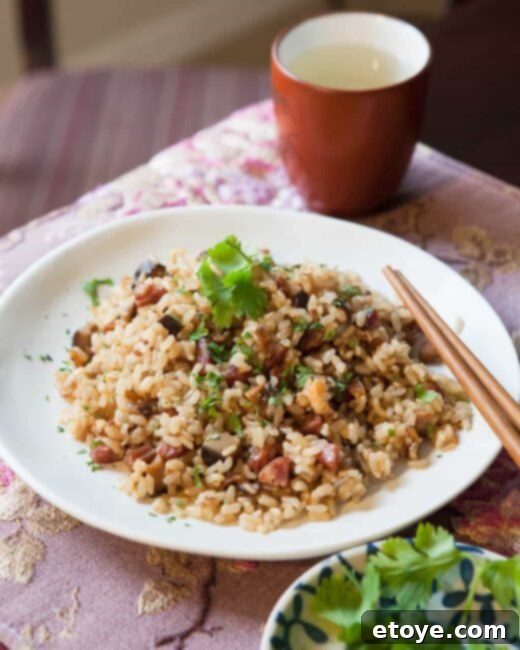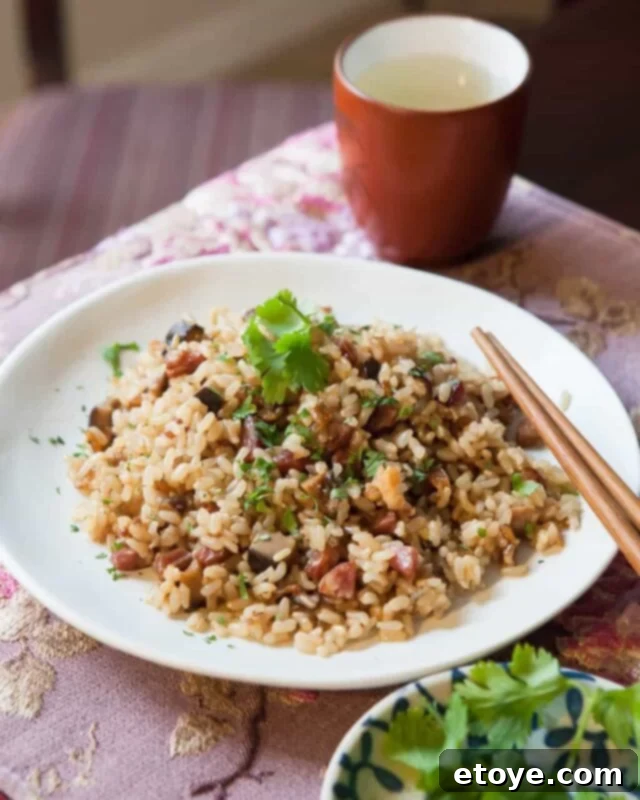
Authentic Hakka-Inspired Pressure Cooker Chinese Sausage and Brown Rice
Experience the rich tapestry of traditional Chinese flavors with a healthful, modern twist. This exquisite pressure cooker recipe showcases some of the most cherished dried and preserved Chinese ingredients: plump dried shrimp, succulent Chinese sausage (lap cheong), and earthy dried mushrooms. While classic versions of this hearty dish typically feature white or sticky glutinous rice, we’ve opted for nutrient-rich brown rice, transforming it into a wholesome meal without compromising on its authentic taste. This comprehensive guide will not only walk you through preparing this savory rice dish in a fraction of the time using a pressure cooker, but also equip you with expert tips on selecting, storing, and utilizing these cornerstone ingredients in your everyday cooking.
Imagine a rice dish that’s both deeply savory and incredibly satisfying – that’s precisely what this recipe delivers. It draws a close resemblance to the beloved Sticky Rice with Chinese Sausage often found in bustling Dim Sum establishments, yet it offers a less sweet profile, thanks to the absence of added sugar and the inclusion of wholesome brown rice. This adaptation is a testament to blending heritage with health-conscious choices, creating a dish that truly nourishes the body and soul.
A Culinary Journey: The Hakka Connection
This recipe holds a special place, stemming from my mother’s Hakka heritage. The Hakka people, originating from the southeastern Guangdong region of China, are known for their distinct and resilient culinary traditions. Unlike many Chinese communities that identify strongly with a specific geographical locale, “Hakka” literally translates to “Guest Family,” reflecting their history as migratory people. This transient past means Hakka cuisine often emphasizes preserved ingredients and robust, comforting flavors designed to travel well and provide sustenance.
My grandparents, part of this vibrant diaspora, embarked on a courageous journey to Hong Kong in the 1960s – a story filled with daring escape that deserves to be told another day. Their resilience and culinary ingenuity deeply influence dishes like this one, which is an adaptation of a traditional Hakkanese recipe. By incorporating a pressure cooker and swapping white rice for brown, we honor the spirit of innovation while preserving the essence of a cherished family legacy. Finding authentic Hakka cookbooks can be challenging due to their migratory history; one notable English resource is “The Hakka Cookbook by Linda Anusasananan,” an invaluable treasure that beautifully chronicles the history, culture, and recipes of these Chinese “nomads.”
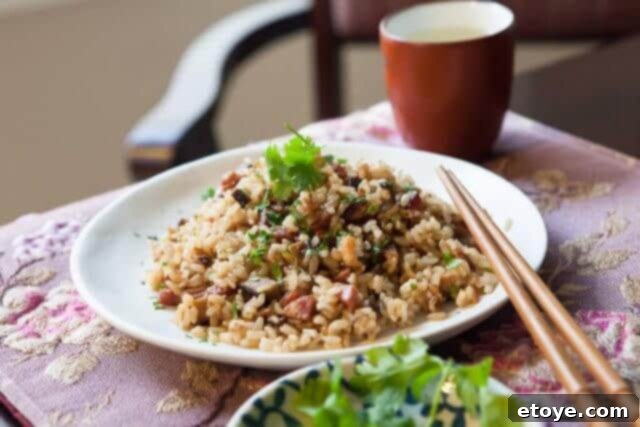
Mastering the Pressure Cooker: Efficiency and Flavor
Integrating a pressure cooker into this recipe isn’t just a matter of convenience; it’s a game-changer for both efficiency and flavor development. Using a pressure cooker drastically reduces the overall cooking time by more than half, making this complex-tasting dish achievable even on busy weeknights. Through extensive testing, we’ve discovered that brown rice, in particular, reaches its peak texture and flavor when cooked under pressure, yielding a perfectly tender yet distinct grain every time.
For this recipe, we’re utilizing the Instant Pot, which stands out as our top recommendation among electric pressure cookers. Between my mother and myself, we’ve experimented with five different brands, and the Instant Pot consistently emerges as our favorite for its reliability and versatility. Whether you own an electric or a manual stovetop pressure cooker, this recipe has been specifically designed to maximize the advantages of pressure cooking, ensuring consistent and delicious results. If you’re curious to learn more about our experiences and why we love it, check out our in-depth Instant Pot review.
Why Pressure Cook Brown Rice?
Brown rice, with its outer bran layer, typically requires a longer cooking time than white rice. Pressure cooking provides the ideal environment for breaking down this tougher exterior, allowing the grains to absorb moisture more efficiently and cook evenly. The result is brown rice that’s wonderfully chewy yet tender, mimicking the desirable texture of glutinous rice but with all the added nutritional benefits of whole grains. This method also infuses the rice deeply with the savory flavors of the other ingredients, creating a remarkably cohesive and aromatic dish.
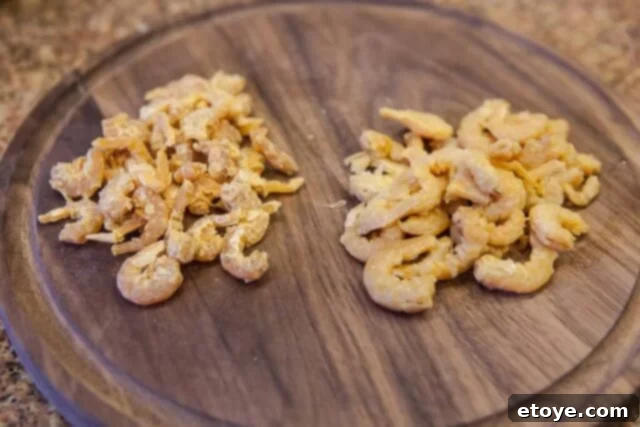
Left: dried shrimp Right: after soaking
Essential Chinese Ingredients: Building Flavor Foundations
The magic of this dish lies in its trifecta of preserved ingredients, each contributing a unique layer of umami and depth that defines authentic Chinese cuisine. Understanding these ingredients – how to choose them, store them, and prepare them – is key to unlocking the full potential of your cooking.
Dried Shrimp: Umami Powerhouse
Dried shrimp are small, intensely flavorful shrimp that have been salted and sun-dried (though modern methods often use industrial ovens). Ranging in size from a pinky nail to a quarter, these culinary gems are celebrated for their concentrated umami, offering a naturally salty-sweet-savory punch to a wide array of dishes. They are indispensable in Chinese cooking, frequently used to establish a foundational flavor in soups, stir-fries, and rice dishes, much like how a rich broth forms the base for Western cooking. You might have encountered them whole in a braised cabbage dish or finely minced in a flavorful fried rice.
Think of dried shrimp as a natural flavor enhancer that imparts a delightful briny note without being overtly “fishy.” In fact, even my seafood-averse husband enjoys dishes prepared with minced dried shrimp, often without even noticing their presence, yet always appreciating the subtle, delicious depth they bring. I often describe their effect to newcomers as similar to how a small amount of chopped bacon can utterly transform and elevate a dish.
How to Buy Dried Shrimp:
- Size Matters (for Cost and Soaking): Larger shrimp tend to be more expensive and require longer soaking times. Smaller shrimp are generally saltier, necessitating a longer soak to balance the flavor.
- My Preference: I typically opt for small-sized dried shrimp. They are budget-friendly and still provide exceptional flavor.
- Where to Find Them: Look for dried shrimp in Asian markets, usually near other dry goods like dried mushrooms, or sometimes in the refrigerated section. Some markets even offer them in bulk.
- Visual Cues: Choose shrimp that are pink or coral-colored and appear whole. Avoid those that are dark, grey, ash-colored, or broken, as these indicate older or poor-quality batches.
Storing Dried Shrimp:
- Refrigeration or Freezing: Always store dried shrimp in the refrigerator or freezer. My mother often divides a large bag into smaller portions, keeping one in the fridge for immediate use and freezing the rest to maintain freshness.
- Shelf Life: Dried shrimp can go stale over time, indicated by a greyish or ashy discoloration. When you notice this, it’s time to replace them with a fresh batch.
Using Dried Shrimp in Cooking:
- Soaking for Flavor and Texture: Soaking rehydrates the shrimp and helps to bring out more of their nuanced flavor while making them more tender. Place a handful of small dried shrimp in a bowl and cover with cool water for about 30 minutes, or use just-boiled hot water for 10 minutes for a quicker soak. This is a guideline; don’t over-soak for hours, as the shrimp can begin to lose their flavor into the water. Some cooks even use them directly without soaking for a more intense burst of flavor!
- Discarding Soaking Water: While some traditional recipes call for using the soaking water, we typically discard it now. It can sometimes contain grit or impurities that you don’t want in your final dish.
- Adjust Seasoning: Remember that dried shrimp are inherently salty, so be sure to taste your dish and adjust other seasonings accordingly, adding less salt initially.

Chinese Sausage (lap cheong)
Chinese Sausage (Lap Cheong): A Culinary Gem
Known as lap cheong in Cantonese or là cháng in Mandarin (臘腸/腊肠), Chinese sausage is a true culinary marvel, often playfully dubbed “the bacon of the East” for its irresistible combination of sweet, salty, savory, and fatty flavors. These sausages are crafted from seasoned fatty pork or duck (or a blend), encased, strung, and then smoked as they hang. Lap cheong is a versatile staple in Chinese cuisine, making appearances in countless dishes:
- Tucked into soft, white steamed buns at dim sum.
- Adding depth to fried rice.
- Simply steamed with rice for an easy meal.
- A key component in flavorful Clay Pot Chicken.
- Featured in elegant Sticky Rice in Lotus Leaf (Lo Mai Gai).
- Even replacing bacon in creative fusion dishes like Roasted Brussels Sprouts with Chinese Sausage.
How to Buy Chinese Sausage:
- Location: You’ll typically find Chinese sausage in the dry goods aisle or refrigerated section of Asian markets.
- Packaging: Opt for packages that are tightly shrink-wrapped, avoiding loose bags with air pockets that can compromise freshness. While some Chinese markets or delis may sell them hanging unpackaged, it’s generally best to avoid these unless you’re at a high-turnover Chinatown market known for fresh, quickly cycled inventory.
- Color and Fat: Look for a deep, dark reddish hue. A dull brown color might indicate older sausage, unless it specifically contains liver, which naturally darkens it (though I personally prefer those without liver). When sliced, the tiny cubes of fat within the sausage should be opaque and pearly white, a sign of quality.
- Fat Content: Brands vary widely in fat content. More fat often means more flavor, but excessive fat can make your dish greasy. Choose based on your preference.
- Brands: Kam Yen Jen is a widely available and popular brand made in the USA, a reliable choice outside of major Chinatowns. For superior quality, my mother’s friend often brings back “Happy Meat” brand from Toronto – a memorable name for excellent sausage!
Storing Chinese Sausage:
- Unopened: Unopened packages can last for several months in a cool, dark pantry. However, refrigeration extends their shelf life considerably. For multiple packages, I refrigerate one and freeze the rest.
- Opened: Once opened, tightly wrap any unused links in plastic wrap, then foil, before refrigerating. This prevents the strong sausage aroma from permeating other foods in your fridge.
- Spoilage Signs: Discard sausage if it has turned dark or if the internal fat, when cut, is no longer pearly white.
How to Use Chinese Sausage:
- Whole with Rice: For a simple, flavorful meal, steam whole links directly with rice, as shown in our Chinese Sausage with Rice Recipe. You can even add them straight from the freezer into your rice cooker or pressure cooker.
- Dicing for Stir-Fries: When adding to stir-fries or fried rice, typically 2-3 links are sufficient. Dice the sausage and add it to a wok or sauté pan over medium-low heat. As the pan warms, the sausage fat will slowly render and caramelize. Once browned and slightly darker, use a slotted spoon to remove the sausage, leaving the flavorful rendered fat behind. This fat is perfect for cooking other ingredients in your stir-fry. If your sausage is very lean and doesn’t release much fat, a swirl of cooking oil can kickstart the process.
- Preventing Burning: Chinese sausage has a high sugar content, making it prone to burning quickly. Cooking it separately first ensures perfect caramelization without scorching, and allows you to capture its delicious rendered fat.
- Seasoning Adjustments: Given its inherent sweetness and saltiness, go easy on additional seasonings until the end, tasting and adjusting as needed.
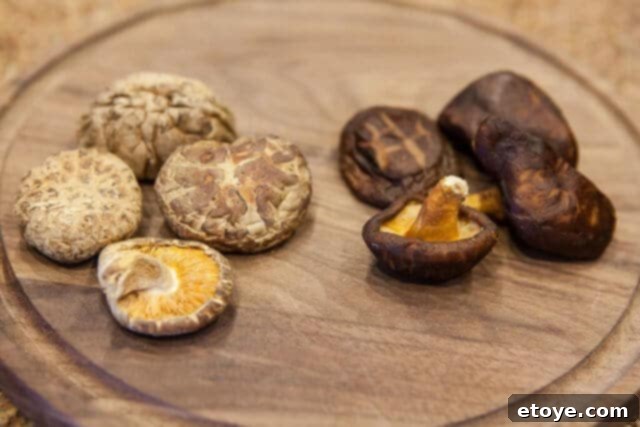
Left: Chinese dried black mushroom Right: after soaking
Chinese Dried Mushrooms: Depth of Flavor
A true cornerstone in Chinese cooking, dried black mushrooms (often labeled as dried shiitake) are renowned for imparting an intense umami flavor – a recurring theme in this dish! They are a natural, vegetarian, and vegan-friendly way to introduce profound “meaty” and savory notes, along with a satisfying texture, to any recipe.
While you might be familiar with Japanese “Shiitake” mushrooms, which are generally thinner and more delicate, the popular Chinese style of dried black mushroom typically features a thick, sturdy cap and a stout stem. These require soaking before they can be used in braises, stir-fries, or, as in this recipe, incorporated into rice dishes.
How to Buy Chinese Dried Mushrooms:
- Availability: These mushrooms are readily available in most Asian markets and are increasingly found in larger mainstream supermarkets and health food stores like Whole Foods.
- Quality Indicators: For Chinese-style cooking, seek out mushrooms with thick caps and short, stout stems. Although they take longer to soak, these varieties offer superior flavor and a more substantial texture. Look for whole, unbroken mushrooms with a slightly swollen, puckered, and crinkly cap. The highest quality mushrooms often resemble a tortoise shell, displaying a beautiful interplay of dark brown and light beige crinkles.
- Packaging: While available in bulk, I prefer pre-sealed packages. The crinkles of bulk mushrooms can easily trap dust and dirt.
- Pre-sliced vs. Whole: I keep both whole, thick Chinese-style mushrooms and thinner, pre-sliced dried mushrooms on hand. The pre-sliced variety is excellent for stir-fries, as it halves the soaking time and offers added convenience.
How to Store Chinese Dried Mushrooms:
- Longevity: Dried mushrooms boast an impressive shelf life, lasting for a couple of years if stored correctly.
- Best Practices: Keep them in an airtight glass jar or plastic zip-top bags in your pantry. Be aware that storing them in plastic containers for extended periods can impart a lasting mushroom aroma to the container itself.
How to Use Chinese Dried Mushrooms:
- Crucial Soaking: Always soak dried mushrooms before use. Place them in a deep bowl and cover with water. Since they float, you can use a smaller plate to weigh them down and ensure full submersion, which can help shorten soaking time. Thicker caps will naturally require longer soaking.
- Cool Water: At least 1 hour.
- Just-boiled Hot Water: Approximately 30 minutes. If you’re pressed for time, microwave them in hot water for about 3 minutes, then let them sit for another 10 minutes.
- Readiness Check: The mushroom is ready when it can be easily cut or chopped.
- Soaking Water: While some cooks advocate using the soaking water for added flavor, I personally prefer to discard it. The water can contain grit and impurities that might affect the cleanliness of your dish.
- Stems: Don’t discard the trimmed stems! Store them in a baggie in the freezer. They are fantastic for adding depth to homemade soups and stocks – just add them to the pot and discard after simmering, as they remain tough to eat.
- Cooking Adaptability: Dried mushrooms are incredibly forgiving and difficult to overcook. Their texture holds up beautifully under prolonged cooking. In stir-fries, it’s often beneficial to add them early to allow them ample time to soften and fully integrate their flavors.

Choosing Your Rice: Brown Rice for Health and Texture
While many traditional Chinese rice dishes feature white or glutinous sweet rice, this recipe embraces the nutritional advantages of brown rice. We’re using medium-grain brown rice, which, when pressure-cooked, develops a wonderful chewiness and tender texture that surprisingly closely resembles that of glutinous sweet rice. This allows us to create a dish that is not only robust in flavor but also significantly more healthful, offering increased fiber and nutrients without sacrificing the satisfying mouthfeel characteristic of Asian rice preparations. Feel free to experiment with other rice varieties if preferred, but for this specific recipe, brown rice truly shines.

Step-by-Step: Pressure Cooker Chinese Sausage and Brown Rice
Preparing this flavorful rice dish in your pressure cooker is straightforward, but a few key steps ensure maximum flavor and perfect texture. Here’s a visual and descriptive guide to the process:
The first step involves preparing your key aromatics and flavorful ingredients. Carefully dice the soaked dried shrimp, the fragrant Chinese sausage, the rehydrated dried mushrooms, and one shallot. These ingredients will form the savory foundation of your dish.
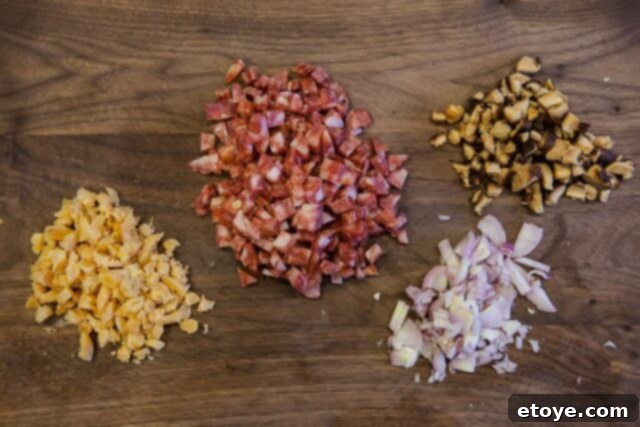
Once diced, these four ingredients will undergo a brief stir-frying process. This crucial step is designed to awaken and intensify their unique flavors. Notice how we’ll be adding the ingredients to the wok separately; this technique ensures that each component is cooked optimally, allowing their individual characteristics to shine before they meld together.
Begin by stir-frying the minced shallots. Heat a wok over medium heat, swirl in the cooking oil, and add the shallots. Sauté for about 30 seconds until fragrant, taking care not to burn them.
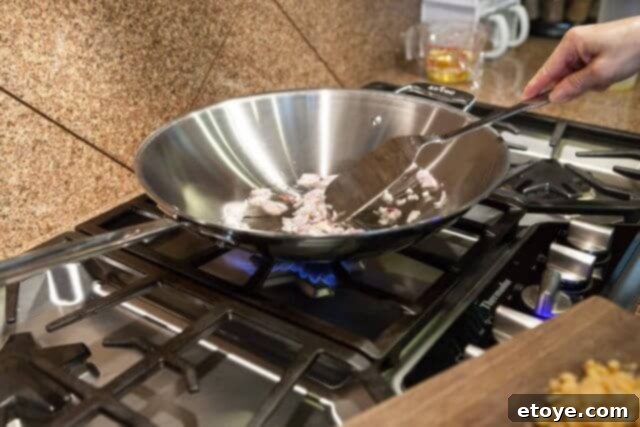
Next, add the diced dried shrimp to the wok with the shallots. Continue to stir-fry for approximately 2 minutes. The shrimp will become aromatic and slightly crisp, contributing its briny umami to the developing flavor base. Remember to adjust the heat as needed to prevent the shallots from burning.
Following the shrimp, incorporate the diced dried mushrooms. Stir-fry for another minute, allowing them to absorb some of the oil and release their earthy fragrance.

Finally, add the diced Chinese sausage to the wok. Continue to stir-fry. As the sausage cooks, its delicious fats will slowly render and become transparent, and the sausage pieces themselves will deepen in color, indicating perfect caramelization. This is where a lot of the magic happens, as the sausage’s sweet and savory notes infuse the oil.
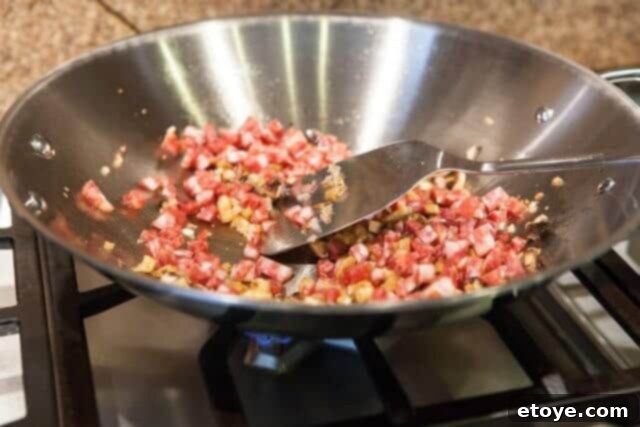
Once the Chinese sausage has taken on a darker hue and its internal fats have melted and become transparent, the stir-frying is complete. It’s crucial to monitor the heat carefully throughout this stage to ensure the shallots and other ingredients caramelize beautifully without burning. This layered stir-fry technique builds a complex flavor profile for your rice.

Transfer the beautifully stir-fried ingredients into the pressure cooker pot. Add the rinsed brown rice, ensuring it’s evenly distributed among the flavorful aromatics.
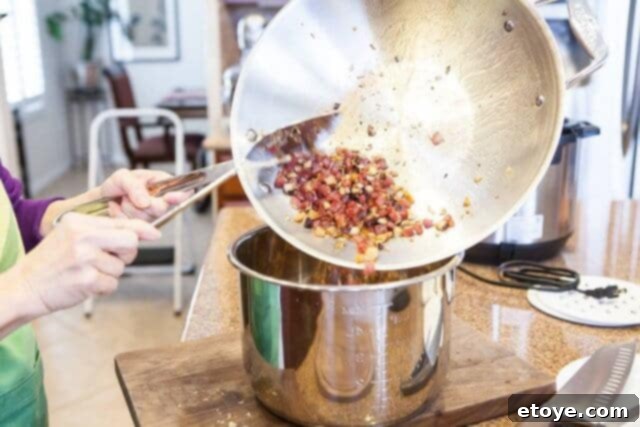
Pour in the liquid. You can use plain water for a neutral base, or enhance the richness with vegetable broth or chicken broth, which will imbue the rice with even more savory depth.
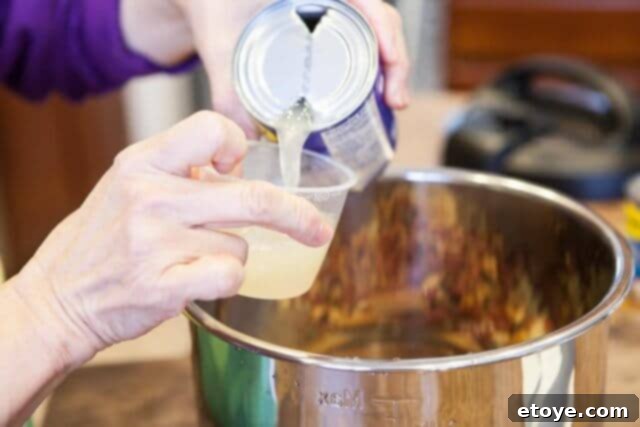
Close the pressure cooker lid, ensuring it’s sealed correctly. Set your pressure cooker to cook under high pressure for 30 minutes. This duration is perfectly calibrated to cook the brown rice to a tender, chewy perfection while allowing all the flavors to meld.
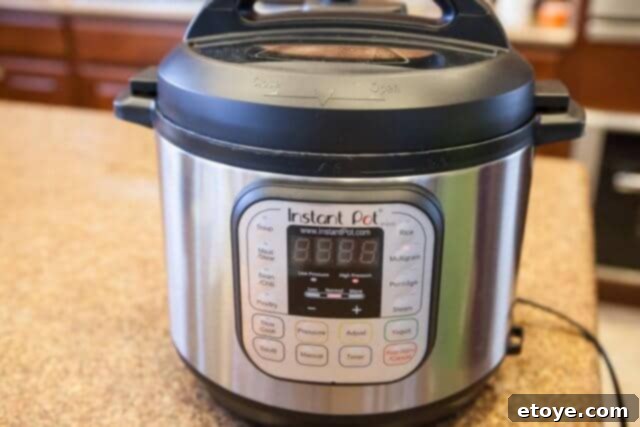
Once the pressure cooking cycle is complete, turn off your pressure cooker. Critically, allow it to rest for a natural pressure release for 10 minutes. This crucial resting period allows the pressure to drop gradually, preventing the rice from becoming sticky and ensuring a fluffy texture. After 10 minutes, carefully release any remaining pressure. I recommend using tongs and a kitchen towel to direct the steam away from your face and hands, as the steam will be extremely hot.

Your Pressure Cooker Chinese Sausage and Brown Rice is now ready to be served! Fluff with a fork, garnish with fresh chopped cilantro, and enjoy the rich, authentic flavors.
The Ultimate Pressure Cooker Chinese Sausage and Brown Rice Recipe
A Note on Measuring Cups: Please be aware that in this recipe, “cups” for rice and broth refer to standard American measuring cups, not the smaller Asian rice cups often included with rice cookers or pressure cookers. For reference, 1 Asian rice cup is approximately 3/4 of a standard American measuring cup. This recipe is suitable for both electric and manual stovetop pressure cookers.
Prep Time: 40 mins
Cook Time: 30 mins
Resting Time: 10 mins
Servings: 4-6
Rating: 4.25 out of 5 stars (based on 4 votes)
Ingredients
- 1/2 cup dried shrimp
- 4 Chinese dried mushrooms
- 3 Chinese sausage (lap cheong), diced
- 2 tablespoons cooking oil
- 1 shallot, minced
- 1 1/4 cups medium-grain brown rice, rinsed and drained
- 3 cups chicken or vegetable broth
- 1/4 cup chopped fresh cilantro, for garnish
Instructions
- Soak Dried Ingredients: In a small bowl, add the dried shrimp and cover with just-boiled hot water. Let them soak for 10 minutes, then drain and discard the water. In a separate small bowl, place the dried mushrooms and cover them with just-boiled hot water. Allow them to soak for 30 minutes, then drain and discard the water. Once soaked, finely chop or dice both the shrimp and mushrooms.
- Stir-Fry Aromatics and Meats: Heat a wok or a large sauté pan over medium heat. Once hot, add the cooking oil and swirl to coat the pan. Add the minced shallot and stir-fry for 30 seconds until fragrant. Next, add the chopped dried shrimp and continue to stir-fry for 2 minutes, being mindful not to burn the shallot (adjust heat if necessary). Then, add the chopped dried mushrooms and the diced Chinese sausage, stir-frying for another minute until the sausage begins to caramelize and its fat renders transparent.
- Combine and Pressure Cook: Transfer all the stir-fried ingredients into your pressure cooker pot. Add the rinsed and drained brown rice and pour in the chicken or vegetable broth. Secure the pressure cooker lid and set it to cook on high pressure for 30 minutes.
- Release Pressure and Serve: Once the cooking cycle is complete, turn off the pressure cooker and allow it to naturally release pressure for 10 minutes. After 10 minutes, carefully quick-release any remaining pressure (use tongs and a kitchen towel to direct steam away from you, as it will be very hot). Open the lid, fluff the rice gently with a fork, and garnish generously with fresh chopped cilantro before serving.
Frequently Asked Questions (FAQs)
Can I use white rice instead of brown rice?
Yes, you can certainly use white rice if you prefer, but the cooking time will need to be adjusted significantly. White rice, such as jasmine or basmati, typically cooks much faster under pressure (around 5-7 minutes with a 10-minute natural release). If using sticky glutinous rice, its texture will be different from brown rice, and the cooking time will also vary. For the best flavor and nutritional benefits, and to achieve the desired chewy-tender texture that mimics glutinous rice, brown rice is highly recommended for this particular recipe.
What if I don’t have a pressure cooker?
While this recipe is optimized for a pressure cooker for speed and ideal brown rice texture, you can adapt it for stovetop cooking. You would prepare the dried ingredients and stir-fry them as instructed. Then, combine them with the rinsed brown rice and broth in a heavy-bottomed pot. Bring to a boil, then reduce heat to low, cover tightly, and simmer for approximately 45-50 minutes, or until the liquid is absorbed and the rice is tender. You may need a bit more liquid and a longer rest time (10-15 minutes) off the heat before fluffing and serving. The flavors will still be delicious, though the brown rice texture might differ slightly.
How can I make this dish vegetarian?
To make this dish vegetarian, simply omit the dried shrimp and Chinese sausage. You can replace them with additional dried shiitake mushrooms for extra umami, or include firm tofu or tempeh, diced and pan-fried until golden, for protein. Ensure you use vegetable broth instead of chicken broth. While the distinct flavors of dried shrimp and Chinese sausage are central to the original profile, a vegetarian version can still be incredibly flavorful by emphasizing the dried mushrooms and other savory aromatics.
Conclusion
This Pressure Cooker Chinese Sausage and Brown Rice recipe is more than just a meal; it’s an homage to rich Hakka culinary traditions, brought into the modern kitchen with health and convenience in mind. By mastering the art of utilizing preserved ingredients and harnessing the power of the pressure cooker, you can create a deeply satisfying, flavorful, and wholesome dish that tells a story with every bite. We encourage you to embark on this culinary adventure and bring the authentic tastes of Chinese heritage to your own table. Enjoy the journey and the delicious results!
